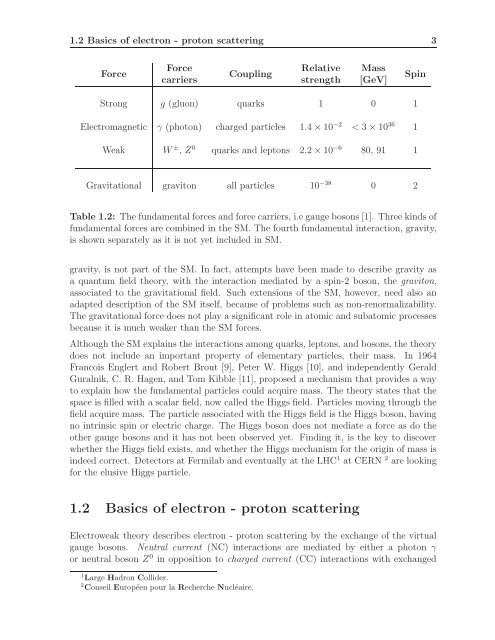10 - H1 - Desy
10 - H1 - Desy
10 - H1 - Desy
You also want an ePaper? Increase the reach of your titles
YUMPU automatically turns print PDFs into web optimized ePapers that Google loves.
1.2 Basics of electron - proton scattering 3<br />
Force<br />
Force<br />
Relative Mass<br />
Coupling<br />
carriers strength [GeV]<br />
Spin<br />
Strong g (gluon) quarks 1 0 1<br />
Electromagnetic γ (photon) charged particles 1.4 × <strong>10</strong> −2 < 3 × <strong>10</strong> 36 1<br />
Weak W ± , Z 0 quarks and leptons 2.2 × <strong>10</strong> −6 80, 91 1<br />
Gravitational graviton all particles <strong>10</strong> −38 0 2<br />
Table 1.2: The fundamental forces and force carriers, i.e gauge bosons [1]. Three kinds of<br />
fundamental forces are combined in the SM. The fourth fundamental interaction, gravity,<br />
is shown separately as it is not yet included in SM.<br />
gravity, is not part of the SM. In fact, attempts have been made to describe gravity as<br />
a quantum field theory, with the interaction mediated by a spin-2 boson, the graviton,<br />
associated to the gravitational field. Such extensions of the SM, however, need also an<br />
adapted description of the SM itself, because of problems such as non-renormalizability.<br />
The gravitational force does not play a significant role in atomic and subatomic processes<br />
because it is much weaker than the SM forces.<br />
Although the SM explains the interactions among quarks, leptons, and bosons, the theory<br />
does not include an important property of elementary particles, their mass. In 1964<br />
Francois Englert and Robert Brout [9], Peter W. Higgs [<strong>10</strong>], and independently Gerald<br />
Guralnik, C. R. Hagen, and Tom Kibble [11], proposed a mechanism that provides a way<br />
to explain how the fundamental particles could acquire mass. The theory states that the<br />
space is filled with a scalar field, now called the Higgs field. Particles moving through the<br />
field acquire mass. The particle associated with the Higgs field is the Higgs boson, having<br />
no intrinsic spin or electric charge. The Higgs boson does not mediate a force as do the<br />
other gauge bosons and it has not been observed yet. Finding it, is the key to discover<br />
whether the Higgs field exists, and whether the Higgs mechanism for the origin of mass is<br />
indeed correct. Detectors at Fermilab and eventually at the LHC 1 at CERN 2 are looking<br />
for the elusive Higgs particle.<br />
1.2 Basics of electron - proton scattering<br />
Electroweak theory describes electron - proton scattering by the exchange of the virtual<br />
gauge bosons. Neutral current (NC) interactions are mediated by either a photon γ<br />
or neutral boson Z 0 in opposition to charged current (CC) interactions with exchanged<br />
1 Large Hadron Collider.<br />
2 Conseil Européen pour la Recherche Nucléaire.
















